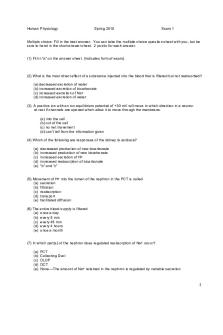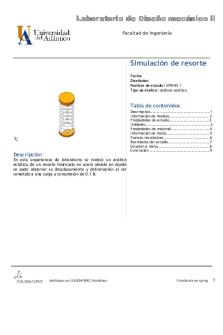Exam 1 Spring 15 - fdafda PDF

| Title | Exam 1 Spring 15 - fdafda |
|---|---|
| Course | Human Physiology |
| Institution | University of Nebraska-Lincoln |
| Pages | 6 |
| File Size | 87.2 KB |
| File Type | |
| Total Downloads | 73 |
| Total Views | 178 |
Summary
fdafda...
Description
Human Physiology
Spring 2015
Exam 1
Multiple choice. Fill in the best answer. You can take the multiple choice question sheet with you, but be sure to hand in the short-answer sheet. 2 points for each answer.
(1) Fill in “a” on the answer sheet. (Indicates form of exam).
(2) What is the most direct effect of a substance injected into the blood that is filtered but not reabsorbed? (a) decreased excretion of water (b) increased excretion of bicarbonate (c) increased excretion of Na+ (d) increased excretion of water (3) A positive ion with an ion equilibrium potential of +30 mV will move in which direction in a neuron at rest if channels are opened which allow it to move through the membrane. (a) into the cell (b) out of the cell (c) no net movement (d) can’t tell from the information given (4) Which of the following are responses of the kidney to acidosis? (a) (b) (c) (d) (e)
decreased production of new bicarbonate increased production of new bicarbonate increased secretion of H+ increased reabsorption of bicarbonate “b” and “c”
(5) Movement of H+ into the lumen of the nephron in the PCT is called (a) secretion (b) filtration (c) reabsorption (d) transport (e) facilitated diffusion (6) The entire blood supply is filtered (a) once a day (b) every 5 min (c) every 45 min (d) every 4 hours (e) once a month
(7) In which part(s) of the nephron does regulated reabsorption of Na+ occur? (a) (b) (c) (d) (e)
PCT Collecting Duct DLOP DCT None—The amount of Na+ retained in the nephron is regulated by variable secretion
1
(8) Which parts of the nephron is(are) major sites of glucose reabsorption? (a) PCT and DLOH (b) PCT and ALOH (c) PCT only (d) PCT and DCT (e) DLOH and DCT
(9) What percentage of K+ retention by the kidney is regulated? (a) 90% (b) 65% (c) 10% (d) 2% (e) 0%
(10) Action potentials can be produced in which of the following? (a) axons (b) muscle cells (c) cell bodies of neurons (d) all the above (e) “a” and “b”
(11) A large number of neurotransmitter molecules can be released simultaneously through the cell membrane by which process (a) facilitated diffusion (b) receptor-mediated endocytosis (c) neurotransmitter pump (d) diffusion (e) bulk transport (12) Cystic fibrosis is caused by a defective (a) K+ channel, (b) Na/K pump, (c) Cl- channel, (d) ion regulating hormone, (e) none of the above (13) Which of the following can not concentrate molecules inside the cell? (a) Na+/K+ pump (b) primary active transport (c) secondary active transport (d) ion channel (e) “b” and “c” (14) Where is most of the water in the body found that is outside of cells? (a) in the lungs (b) in the lumen of the nephron (c) inside the circulatory system (d) in the spaces between cells (interstitial spaces)
2
(15) The juxtaglomerular apparatus does which of the following: (a) secretes aldosterone (b) measures blood pressure (c) secretes antidiuretic hormone (d) secretes angiotensin (e) none of the above
(16) The Nodes of Ranvier are important in (a) (b) (c) (d) (e)
filtration production of action potentials in the axon production of a graded potential in the cell body maintenace of high osmolality of the kidney reabsorp tion
(17) Which of the following play(s) an important role in glucose reabsorption in the nephron? (a) facilitated diffusion of glucose into the lumen (b) primary active transport of glucose out of the lumen (c) primary active transport of glucose out of the basolateral side of the nephron tubule cell (d) Secondary active transport of glucose out of the lumen (e) None of the above
(18) Which of the following are important for maintaining proper osmolality in the kidney under normal conditions (a) Na+ (b) Urea (c) Glucose (d) All the above (e) “a” and “b” (19) Which type of cell supports or aids the functioning of neurons? (a) glial cells (b) podocytes (c) lammelocyte (d) B cell (e) none of the above
(20) Which of the following are involved in protein synthesis? (a) transfer RNA, (b) messenger RNA, (c) ribosomal RNA (d) all the above, (e) “a” and “b” (21) The fluid mosaic model means that (a) the internal contents of a cell are primarily a fluid containing a mosaic of proteins (b) phospholipids in the cell membrane are a fluid, not held together by covalent bonds (c) proteins in the membrane are mobile and can move through the membrane (d) all the above (e) “b” and “c”
3
+
(22) Na can move in and out of the cells (a) (b) (c) (d) (e)
through channels by secondary active transport by the Na+/K+ pump all the above “a” and “c”
(23) The main defining feature of lipid is which of the following? (a) absence of phosphorus (b) absence of nitrogen (c) presence of carbon (d) insolubility in water (e) presence of fatty acid (24) Which of the following is an integral transmembrane protein? (a) (b) (c) (d) (e)
glucose transporter ion channel phospholipid none of the above “a” and “b”
(25) Which of the following is a characteristic of an action potential (AP) but not a graded potential? (a) (b) (c) (d) (e)
APs can be summed An AP is local, occurring over a short distance The magnitude of the AP is dependent upon the strength of the stimulus All the above None of the above
(26) What is the membrane threshold potential that triggers the main depolarization in the action potential? (a) (b) (c) (d) (e)
– 90 mV -70 mV -50 mV 0 mV any of the above—it depends on the specific neuron
4
Human Physiology
Spring 2015
Name ________________________
Exam 1 Seat Number ___________________
Short answer. Be sure to hand in this sheet. Each answer (line) counts 2 pts (1) Name the key clinical measure discussed in your notes that is used to determine whether the kidney is functioning properly _________________________________________ (full name).
(2, 3) ____________________is the type of receptor that regulates the release of anti-diuretic hormone.
This hormone causes the insertion of ______________________ in the collecting duct
(4) Name the major part of the kidney that is isosmotic _________________________
(5) Which molecule is the energy source used in primary active transport_______________________
(6) Regulated secretion of K+ is coupled with _________________(a process) that occurs in the distal convoluted tubule
(7) The capillary bed surrounded by Bowman’s capsule is called ___________________
(8) Which enzyme plays a key role in the release of aldosterone ____________________ (9) Excessive water in parts of the body is called __________________________________
(10) Name the part of the neuron in which a graded potential but not an action potential occurs ________________________ (11) Which type of channel opens to cause the dramatic depolarization in an action potential ___________________________________l (12) The absolute refractory period occurs during which part of the action potential _____________________? (13) Name the molecule of the muscarinic receptor that connects the receptor with its ion channel _______________? (14) In no more than one sentence; < 15 words) give the main reason why a nerve impulse is conducted faster in a myelinated axon than in an unmyelinated axon?
5
Longer answers.
(1) 9 pts. Draw a diagram that illustrates the main parts of the bicarbonate shuttle (key molecules or ions; any important enzymes) that occur in the lumen of the nephron (NOT the part that occurs within the tubule cell). In a sentence or two briefly explain the main function of the shuttle and how it works in the lumen.
(2) Draw a figure illustrating the nicotinic receptor discussed in class, labeling its key parts. Where is the receptor located? In no more than 1 sentence explain how the receptor works.
6...
Similar Free PDFs

Exam 1 Spring 15 - fdafda
- 6 Pages

Exam 2 15 Spring 2011, questions
- 4 Pages

Exam 1 Spring semester 2016
- 13 Pages

1. Exam #1 - Version A - Spring 2018
- 14 Pages

Final EXAM FINAL EXAM SPRING
- 8 Pages

Final Exam Spring 18
- 9 Pages

Bio 202 Spring 2019 Exam #1 Erster
- 14 Pages

Sat Comm Exam 1-Spring 17
- 5 Pages

Exam Spring 2017
- 16 Pages

Final Exam Spring 2020
- 5 Pages

Spring 2017 Exam 2
- 6 Pages

Spring- Spring 1-1 - Nota: 10
- 10 Pages

Exam Spring 2020
- 5 Pages

Reading Guide 15 1 15 7 - exam 4
- 1 Pages
Popular Institutions
- Tinajero National High School - Annex
- Politeknik Caltex Riau
- Yokohama City University
- SGT University
- University of Al-Qadisiyah
- Divine Word College of Vigan
- Techniek College Rotterdam
- Universidade de Santiago
- Universiti Teknologi MARA Cawangan Johor Kampus Pasir Gudang
- Poltekkes Kemenkes Yogyakarta
- Baguio City National High School
- Colegio san marcos
- preparatoria uno
- Centro de Bachillerato Tecnológico Industrial y de Servicios No. 107
- Dalian Maritime University
- Quang Trung Secondary School
- Colegio Tecnológico en Informática
- Corporación Regional de Educación Superior
- Grupo CEDVA
- Dar Al Uloom University
- Centro de Estudios Preuniversitarios de la Universidad Nacional de Ingeniería
- 上智大学
- Aakash International School, Nuna Majara
- San Felipe Neri Catholic School
- Kang Chiao International School - New Taipei City
- Misamis Occidental National High School
- Institución Educativa Escuela Normal Juan Ladrilleros
- Kolehiyo ng Pantukan
- Batanes State College
- Instituto Continental
- Sekolah Menengah Kejuruan Kesehatan Kaltara (Tarakan)
- Colegio de La Inmaculada Concepcion - Cebu

